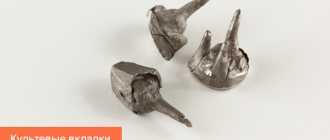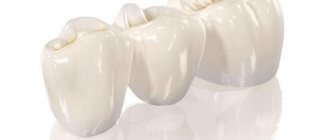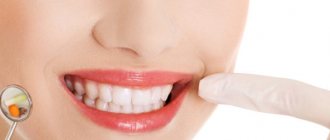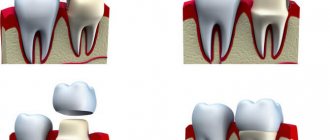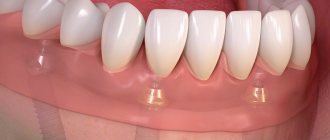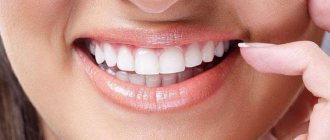January 12, 2018
If the crown or top of the tooth is too badly damaged and it is impossible to fix an artificial crown on it, some kind of support must be installed - this can be a metal pin or a stump inlay. Both of these prostheses are designed to strengthen the tooth root and create support for the crown, since part of them is located above the gum. But they have quite a lot of differences. UltraSmile.ru decided to figure out which of these prostheses is better for restoring a tooth.
What is a stump tab
The stump tab is a structure consisting of two parts: the lower one is a pin that completely repeats the cavity inside the tooth root. The upper one is a small crown, which is covered with a composite or serves as a base for a classic prosthesis - an artificial crown.
Stump tab
Important!
Stump inlays, unlike pins, are created strictly individually, that is, they take into account the anatomy of the tooth. Materials used include alloys of various metals, gold, ceramics and zirconium dioxide.
Sign up to install an E-Max tab at a discount:
But the most common material for dental inlays is ceramic?
Yes, today the most popular material for inlays is E-Max ceramics. This material is also used to make veneers. E-Max ceramics is a modern, aesthetic material that interacts very well with tooth tissue. Such an inlay is attached to the tooth adhesively; this is the strongest adhesion of ceramic restorations to the tooth’s own tissues. Thanks to this technology, the boundaries between the tooth and the inlay are practically invisible. The tooth and the tab fixed to it actually become one whole.
Is the tooth being filed down heavily under the inlay?
Almost the same as for a filling. The only thing is that the tooth tissue is cut down at certain angles, taking into account the installation of the inlay.
If a tooth is badly damaged, is it possible to put an inlay on it?
Yes, you can. Of course, most often inlays are placed on “living” (non-pulpless) teeth that have large cavities, that is, an inlay is placed instead of a large filling. But if necessary, the tab can also be placed on a “dead” (pulpless) tooth. The inlay can last on a “dead” tooth for several years without chipping or breaking.
But it is important to understand that a “dead” tooth does not receive nutrition and is more fragile, so if the load is incorrect, it can break.
Are dental inlays only placed on chewing teeth?
Most often, inlays are placed on chewing teeth. Veneers are usually installed on the front teeth.
Some people complain that after installing this micro dental prosthesis - inlays, the tooth hurts. Why does this happen and what to do in this case?
After the inlay is installed correctly, the tooth should not be disturbed. However, if this happened, then most likely the reason is that the doctor did not follow the procedure protocol
.
An assistant prepares the inlay before installation, and the doctor prepares the tooth. When installing a ceramic inlay, it is very important to isolate the tooth from saliva using a special latex scarf (rubber dam), which isolates the tooth from saliva so that no microflora gets on the prepared tooth. The tooth tissue is treated with a special liquid that eliminates sensitivity.
It should also be noted that all people have different sensitivity; for some, after dentures, the teeth ache during the first 2 weeks - which is normal; for others, they do not hurt at all.
So, if a patient’s tooth hurts for some time after the installation of an inlay, is there a possibility that this pain will subside over time?
Yes, sure. There are so-called “post-filling pains”. The treated tooth may ache for some time when biting after dental treatment. Therefore, it is necessary to give a certain time for recovery. This time varies for each patient, but on average up to one month.
And if the tooth does not subside and continues to hurt, what should you do?
The doctor must analyze the causes and nature of the pain. Often, painful sensations after dental treatment are due to the fact that the patient has an inflamed nerve due to the fact that he has caught a cold. It happens that this neuralgia is associated with stress. There are many reasons, and sometimes they are not related to the work of the dentist. Therefore, in case of pain, it is necessary not only to take photographs of the tooth (X-ray, computed tomography), check the sensitivity of the tooth with a special device, but also analyze the general condition of the patient.
Which tooth is better to place an inlay on – healthy or pulpless?
If possible, it is advisable to install the inlay on a living tooth. Before the procedure, the doctor takes an x-ray. Using it, a specialist looks at the condition of the dental canals and tissues located around the tooth. E-Max ceramics (I-Max) bond better with the tissues of living teeth. By examining an x-ray and the causative tooth in the patient’s mouth, the doctor decides what type of inlay or crown is best to install on the tooth. If it becomes clear to the doctor that the tab cannot withstand the load, then a crown is installed.
What is a dental pin
A dental post is a metal rod with a screw thread. Unlike the tab, it has a standard shape (it differs only in length and diameter). Like stump inlays, the pin is designed to restore a tooth whose crown has been destroyed directly under the root.
The pin is screwed into the root, which must first be cleared of inflammatory processes and sealed. Composite material is applied on top - artistic extension is carried out.
Dental pin
A progressive method that wins
Until recently, the stump pin inlay for a tooth was not used in dentistry.
All reconstructions were fastened with conventional pins. They were extremely popular, they were widely advertised (mainly, of course, by manufacturing companies). The main advantages declared by sellers: the ability to facilitate and speed up the restoration process. Yes, indeed, the doctor used a standard composite reinforced with one or two anchor pins and performed the restoration in 1 session. It seemed that such a design would last forever; it surpassed its warranty period with dignity. But only 2-3 years passed and it collapsed, as the thin walls of the tooth quickly deformed from excessive load. The dentist could fix everything if it was a single crown, but if it was part of a multi-link bridge, the task became more complicated. One way or another, dentistry is actively developing and not so long ago a new device appeared - a stump pin insert. Initially, the tooth inlay did not gain much popularity, as it had a number of disadvantages (its production took longer, and the installation process was complex). Doctors, in order not to waste their time, tried not to advertise this opportunity to patients. But time has passed and now these stump pin inlays are the most in demand and popular. Most progressive dental clinics use them.
Comparing methods: which is better - a stump tab or a pin
So, the question arises, which is better - a stump or a pin? We conducted a brief analysis by comparing the advantages and disadvantages of both prosthetic methods. All characteristics, pros and cons are placed in the table for convenience.
| Pin | Stump tab | |
| Number of doctor visits | 1 visit | 2 visits – during the first, impressions are taken and the tooth is prepared |
| Manufacturing | Pins are template structures | Inlays are created individually in the laboratory |
| Materials | Alloys of inexpensive metals | Ceramics, metal alloys, precious metals, zirconium dioxide |
| Possibility of developing allergies | High | Low, since hypoallergenic materials can be selected |
| Possibilities of prosthetics | The crown is built up on a post using composite materials | Various materials are used: composite building, or crowns (metal-ceramics, ceramics, zirconium dioxide) |
| Aesthetics of prosthetics | Medium – the metal base will be visible, the extended tooth will be noticeably darker | Very high due to the exact repetition of tooth anatomy and the choice of snow-white aesthetic materials |
| Main advantages | Affordable price, possibility of crown repair directly in the patient’s mouth | Root protection from destruction, high aesthetics, long service life |
| Main disadvantages | Rapid destruction of the root under load, relative aesthetics, short service life | High price |
| Life time | No more than 3-5 years | From 3-5 years and above |
| Price | From 4-5 thousand rubles including extensions | From 10 thousand rubles + crown |
To summarize, then, of course, it is worth giving preference to stump inlays. Such dentures ensure the reliability and functionality of the restored tooth. They can last for decades and the tooth will look like a natural one. But inlays are noticeably more expensive, so you need to make a choice primarily based on the condition of the tooth and your budget.
Pros and cons of tabs
To decide which is better, a pin or an inlay, you need to evaluate the strengths and weaknesses of both types of designs. The advantages of tabs are:
- They can withstand high chewing loads and are securely fixed in the root canals.
- Easily replaceable in case of destruction.
- They allow you to restore teeth with curved and even impassable canals.
- Durability and structural strength.
- Possibility to serve as a support for fixed prosthetics (bridge).
Flaws:
- Long production time.
- Careful preparation of dental tissues and significant grinding.
- Long-term treatment: several visits to the dentist will be required.
Watch the video: Dental crown on a core tab
Notice
: Undefined variable: post_id in
/home/c/ch75405/public_html/wp-content/themes/UltraSmile/single-item.php
on line
45 Notice
: Undefined variable: full in
/home/c/ch75405/public_html/wp-content /themes/UltraSmile/single-item.php
on line
46
Rate this article:
crown
How they do it
Metal and metal-ceramic “stump” can be made in two ways - direct and indirect. The first involves performing the following procedures:
- Treatment of dental canals.
- Preparation of treated roots.
- Treatment of formed cavities with a composition that prevents the adhesion of dental material.
- Placement of a viscous base into the channels.
- Removing the frozen model and transferring it to the dental laboratory.
- Production of a prosthesis from the selected material.
The indirect technique is somewhat different. It provides for the following work:
- Preparation of root cavities for prosthetics.
- Taking impressions and transferring them to the dental laboratory.
- Making a plaster model and creating a wax prototype.
- Creation of the final product - a permanent metal support.
Products made from ceramics and zirconium oxide are a new direction in the field of prosthetics. Innovative CAD/CAM technologies are used in their creation. This refers to computer modeling of a miniature prosthesis with subsequent transfer of the obtained parameters to a milling machine. It is the latter that cuts out the microprosthesis. Therefore, the negative influence of the human factor is completely excluded.
Advantages of restoring teeth with pins
To restore a tooth using a pin, you do not need to clean the tooth very much, because the pin is much thinner than the inlay. Thanks to this, the rods have become somewhat more widely used in dental practice. This is one of the first differences that is mentioned when discussing the difference between a pin and an inlay.
The cost of the procedure for manufacturing and installing a pin is slightly lower than restoring a tooth on an inlay. And in terms of timing, treatment rarely requires more than one visit to the dentist. These undeniable advantages have made the method of restoring dental crowns on pins so popular that it is used everywhere.
Manufacturing
The process of making inserts is not as simple as it might seem at first glance. First, the doctor must prepare the remaining living tooth tissue for taking an impression. If necessary, the canals are sharpened until they are parallel, and the inside of the tooth is treated with Vaseline. Special plastic for modeling is diluted to a liquid state, poured into a syringe and carefully inserted into the channels and onto the internal walls, then ashless pins are inserted into the channels.
To create a model of an inlay of the required size, the tooth is limited to a special matrix, along the height of which quick-drying plastic is added. When the plastic hardens, the tab is carefully removed from the tooth. The doctor’s main task at this stage is not to damage the model, since plastic is a very capricious material.
The doctor should check the finished model for defects and pores and eliminate them if possible. If elimination is not possible, it is better to redo the model again. After removing the inlay, the tooth canals should be disinfected and a temporary filling should be placed, and the finished model should be handed over to a dental technician to make a core crown. The manufacture of core inlays for 2-3-root teeth with parallel canals is not very different from single-canal ones, but if the canals are not parallel, the manufacture of a cast or collapsible structure depends on the position of the tooth.
Fixation
Restoring a damaged tooth begins with a step-by-step treatment of its roots. The first thing to do is to remove the nerve and perform a high-quality cleaning of the canals. If these measures are not taken, a strong inflammatory process will occur in the future, due to which the restoration will have to be removed.
The tooth is then prepared from the inside. To do this, the prepared and sealed root canals are carefully unsealed to approximately 1/3-2/3 of the length. Their diameter must be increased. Subsequent procedures involve taking impressions.
When the stump tab is ready, it is installed:
- The damaged tooth is disinfected.
- The prosthesis is degreased and covered with adhesive dental cement.
- A material is placed in the channels that improves the adhesion of artificial fabrics to natural ones.
- Carry out installation.
To ensure that the device is securely fixed, apply strong pressure to the nago. After gluing the supporting element, all that remains is to take impressions and make a crown.
